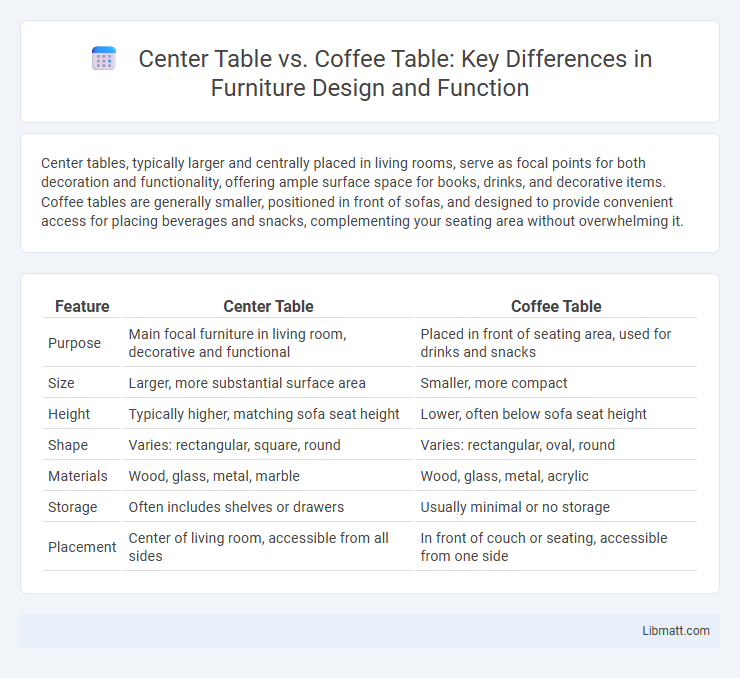Center tables, typically larger and centrally placed in living rooms, serve as focal points for both decoration and functionality, offering ample surface space for books, drinks, and decorative items. Coffee tables are generally smaller, positioned in front of sofas, and designed to provide convenient access for placing beverages and snacks, complementing your seating area without overwhelming it.
Table of Comparison
| Feature | Center Table | Coffee Table |
|---|---|---|
| Purpose | Main focal furniture in living room, decorative and functional | Placed in front of seating area, used for drinks and snacks |
| Size | Larger, more substantial surface area | Smaller, more compact |
| Height | Typically higher, matching sofa seat height | Lower, often below sofa seat height |
| Shape | Varies: rectangular, square, round | Varies: rectangular, oval, round |
| Materials | Wood, glass, metal, marble | Wood, glass, metal, acrylic |
| Storage | Often includes shelves or drawers | Usually minimal or no storage |
| Placement | Center of living room, accessible from all sides | In front of couch or seating, accessible from one side |
Introduction: Center Table vs Coffee Table
Center tables and coffee tables both serve as essential furniture pieces in living rooms, but they differ in size, placement, and functionality. A center table is typically larger, positioned centrally between seating areas, and designed to accommodate items like decorative objects, books, or gaming pieces. Coffee tables are generally smaller, placed in front of sofas, and offer a convenient surface for beverages, snacks, or remote controls, enhancing your living space's comfort and style.
Defining Center Tables and Coffee Tables
Center tables, typically positioned in the middle of a living room, serve as both functional and decorative pieces designed to complement seating arrangements. Coffee tables are lower in height, often placed in front of sofas, providing a surface for beverages, magazines, or remote controls. Understanding the distinction helps you choose the ideal table style that fits your space and enhances your room's aesthetics.
Key Design Differences
Center tables typically feature a larger, more rectangular or square surface, designed as a focal point for gathering spaces, while coffee tables are often smaller and lower, intended for casual use in front of seating areas. The design of a center table emphasizes symmetry and balance, often incorporating storage or display elements, whereas coffee tables prioritize functionality with easy access to beverages and remote controls. Understanding these key design differences helps you select the perfect table to complement your living room's layout and style.
Functionality and Practical Uses
Center tables serve as the focal point in living rooms, offering ample space for decorative items and serving trays, while coffee tables prioritize convenience with a lower height designed for easy access to drinks and snacks. Your choice depends on functionality needs: center tables often accommodate larger gatherings with extra surface area, whereas coffee tables excel in everyday casual use and comfort. Both enhance practicality but cater to different living room dynamics and user preferences.
Popular Materials and Styles
Center tables and coffee tables commonly feature materials such as solid wood, glass, metal, and engineered wood, each offering distinct durability and aesthetic appeal. Popular styles for center tables include minimalist modern, rustic farmhouse, and industrial designs, while coffee tables often embrace mid-century modern, contemporary, and vintage themes. Your choice between a center table and coffee table can be guided by these material options and design preferences to complement your living space.
Room Compatibility and Placement
Center tables, typically larger and more robust, suit spacious living rooms and are usually placed centrally to anchor seating arrangements. Coffee tables are smaller, versatile pieces ideal for compact spaces and often positioned in front of sofas or lounges for easy access. Both tables enhance room functionality but differ in scale and placement depending on room size and layout.
Aesthetic Impact on Interior Decor
Center tables often serve as bold focal points in living rooms, combining functionality with artistic design to enhance your interior decor's visual appeal. Coffee tables typically offer a more subtle aesthetic, balancing practical use with style through sleek designs and versatile materials that complement surrounding furniture. Choosing between a center table and a coffee table depends on the desired statement and harmony within your interior space.
Space Management and Sizing
Center tables typically have larger surface areas designed to anchor seating arrangements, making them suitable for spacious living rooms where ample floor space allows for comfortable navigation around the table. Coffee tables are generally smaller and more compact, optimizing space in cozier rooms by fitting snugly in front of sofas without overwhelming the area. Selecting the appropriate table size ensures efficient space management, balancing functionality and movement flow within the living environment.
Cost Considerations
Center tables generally cost more than coffee tables due to their larger size and more intricate designs, often made from premium materials like solid wood, glass, or metal. Coffee tables tend to be more budget-friendly, with many affordable options available in materials such as MDF, particleboard, or plastic. When evaluating cost considerations, buyers should balance size, material quality, and design complexity to align with their budget and aesthetic preferences.
Choosing the Right Table for Your Home
Choosing the right table for your home depends on the room layout and functional needs: a center table typically serves as a focal point in living rooms, offering ample surface space for decorative items and gatherings, while a coffee table tends to be lower and more compact, designed for casual use near seating areas. Consider dimensions, style, and storage options to enhance both aesthetic appeal and practicality. Material choices like wood, glass, or metal also impact durability and match interior design themes.
Center Table vs Coffee Table Infographic

 libmatt.com
libmatt.com